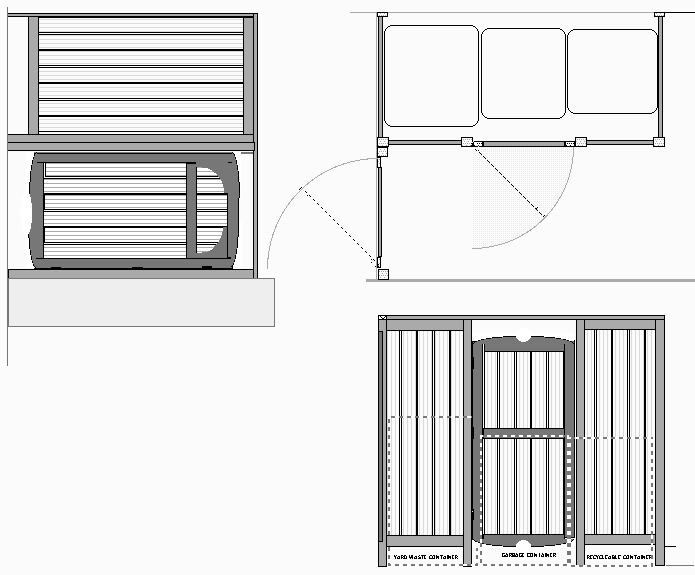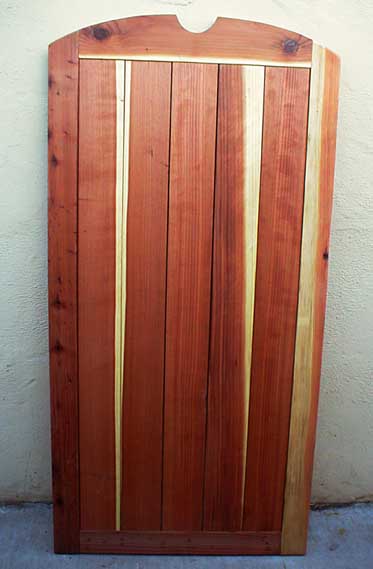Dealing With Change Orders
The great thing about loose tenon mortise and tenon joinery is that you can dry fit what you have in order to get the size of things that have to fit between what you've got. AND - because you can do the whole project BEFORE applying any glue - IF something changes - you can adapt what you have to what you now need.
THAT came in real handy because, when I went out to bring the garbage can back in on Garbage Day - there were two more big plastic wheeled bins with hinged lids sitting on the curb - and one of them was much bigger than the one I had and the new Blue One (for recycling). Apparently we've got a new garbage collection outfit and they now provide THREE containers - garbage, recycleables AND "yard waste" (the BIG ONE).
Surprise! Surprise! Surprise! The three of these things won't fit in the 7 foot long by 3 foot wide space I'd planned for. OH KRANUS!
(note: Kranus is a universal word that can mean almost anything - and sound about right. "Yes Virginia, there really is a Kranus." Or - "The fall nearly broke his kranus." How about, - Grabbing his trusty kranus, he confronted the intruder. The kranus stalked its prey. Would you hand me the kranus snext to that widget over there? I'm collecting donations for the Kranus Society - care to make a contribution?
BUT - if I moved back to the NEXT set of existing fence post - I'd have EIGHT feet of length - which would work fine. Whew - dodged a bullet on that one. So here's Plan B - at 1/2" = 1' scale ( I did a 1"=12" drawing to work out door widths and placement. Still can get away with one door/fate in the "garbage cans surround.- AND - I can use what I've already done. Handy using joinery that allows dry fitting of everything BEFORE committing to glue.

There's a real advantage to doing "modular" stuff. The "fence" elements and the "door/gate" elements of this project are basically the same - similar parts and the same joinery The procedure, once done successfully, is applicable to ALL of the rest of the project. Only the lengths of parts change from module to module. And each module can be completed, including the finish, in a reasonable amount of time and provide a sense of accomplishment to encourage doing the next module. Gratification As You Go, as opposed to days spent cuttuing a bunch of parts to size, then days doing the joinery, an hour or two of assembly, identification of the inevitable OOPS, hours, or even days, of correcting / recovering from mistakes, one big hairy glue up - using every clamp owned - semi-frantic checking for square and flat and straight - before the glue begins to set, waiting semi-patiently for the glue to fully set, unclamping, putting all the clamps away before beginning glue squeeze out clean up, sanding where necessary and the Make or Break application of THE FINISH (the step that is often the scariest part of a project).
The draw back of working "modular" is that it can get BORING. Having a module or two that's different, and it doesn't have to be significantly different, can keep things interesting. This project has two doors to make. Since the height of both isn't constrained because there is no top to the "doorway" there's an opportunity to play with the top - for the example below - it was to do a curve, with a half round"negative space" in the center. Am thinking about turning an element to sit in this space, perhaps using some brass brazing rod to "supsend" it in the opening. And it seemed like a nice idea to cut the "2x6" for the top so that the two knots were somewhat symetric - a flaw made into a "feature". It was also fun flipping and turning and rearranging the five boards that make the center of this door - sapwood always requring a bit of trial and error since the only finish is BLO - which is transparent and doesn't change the color of the wood much and mainly just "pops the grain".

The three solid brass hinges which will support this door will be attached to the left side - the one with all the strong heartwood rather than the other, light end of mainy sapwood. This is a subtle little thing that had to be taken into consideration when deciding what was going where. It would have been very easy to overlook because the center boards which make up most of what you'll see took a lot of flipping and turning and slipping and sliding to get a coherent look. Function must always remain a high priority when designing and building things that will look nice - and work - even if your just making something to hide garbage cans.
<<<-------Back to the Site Index